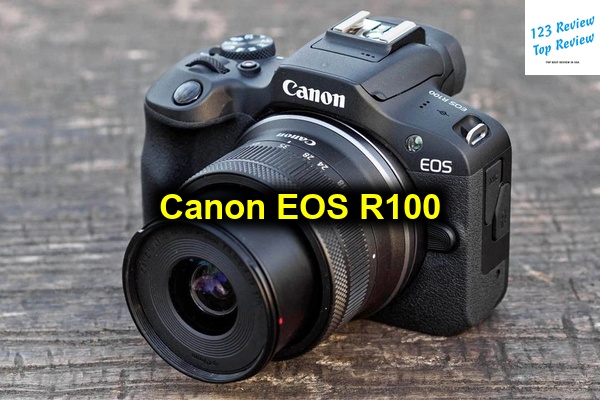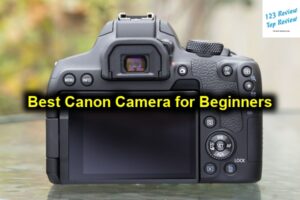The Canon EOS R100 represents an exciting entry in Canon’s growing line of mirrorless cameras, positioned to attract both novice photographers and those stepping up from basic digital cameras or smartphones. With its compact design, user-friendly features, and solid performance, the R100 plays an excellent role for anyone looking to get more serious about photography without the steep learning curve that often accompanies more advanced models.

In this article, 123 Review will explore the R100’s design, specifications, performance characteristics, usability, and its suitability for various photography styles and skill levels.
Design and Build Quality
Size and Weight
One of the standout features of the Canon EOS R100 is its compact size and lightweight design, which makes it easy to carry around. Weighing approximately 390 grams (about 0.86 pounds) with the battery and memory card, the R100 is light enough to bring along on vacations, hikes, or daily outings without adding significant bulk to your gear. This lightweight disposition also benefits photographers who may find themselves shooting for extended periods, as fatigue is mitigated when using a lighter body.
The dimensions of the R100—approximately 116.3 x 87.5 x 68.0 mm (4.58 x 3.44 x 2.68 in)—allow it to fit easily into typical camera bags or larger pockets. This compact nature will appeal to travelers and content creators who want a capable camera that doesn’t take up much space.
Materials Used
Canon has crafted the EOS R100 using high-quality polycarbonate and other durable materials, providing a balance between weight and robustness. The camera feels solid in hand, indicating that it’s built to endure the rigors of everyday use. While it doesn’t feature the premium metal finishes seen in higher-end models, the quality of the materials used still gives it a professional appearance. The careful engineering and thoughtful design also help in resisting the wear and tear that can come with regular shooting.
Ergonomics and Handling
The ergonomics of the Canon EOS R100 are surprisingly good for a camera of its size. The grip is designed to fit comfortably in the hand, with a textured surface that prevents slippage during use, even in challenging conditions. This comfort is vital for capturing sharp images, especially when shooting for longer sessions. The button layout is very user-friendly, with controls such as the shutter release, adjustment dials, and customizable quick access buttons all within easy reach.
The camera also features a thoughtful placement of its LCD screen and electronic viewfinder (EVF), enabling easy switching between composing images through the viewfinder or on the rear display. As a mirrorless camera, the absence of a bulky mirror box allows for a more compact body design. Overall, its ergonomic design makes the EOS R100 accessible to new users while still providing enough functionality for more experienced photographers.
Key Specifications
Sensor Type and Resolution
At the heart of the EOS R100 lies a 24.2 megapixel APS-C CMOS sensor, a popular choice that balances performance and image quality. APS-C sensors are recognized for their ability to produce high-resolution images while ensuring good low-light performance and depth of field control. The R100’s resolution provides the ability to capture fine details, which is crucial whether you’re photographing landscapes, intricate patterns, or portraits.
The sensor is paired with Canon’s DIGIC X image processor, which enhances processing speed and improves performance in various conditions. With this combination, the R100 can produce images that are not only sharp but also vibrant, with rich color reproduction that is characteristic of Canon cameras. The sensor also supports a broad ISO range from 100 to 25600, expandable to 51200, allowing photographers to adapt effectively to numerous lighting situations, from daylight to dimly lit venues.
Lens Mount Compatibility
The EOS R100 utilizes the RF lens mount, which expands your options to Canon’s ever-growing lineup of RF lenses. These lenses utilize advanced optical technology, providing photographers with exceptional image quality and performance. With the RF lens mount, users can enjoy a range of lenses, from wide-angle to telephoto, catering to different photography styles.
Additionally, the total compatibility of Canon’s EF and EF-S lenses is achievable via an adapter. This compatibility means that those transitioning from a Canon DSLR can retain their existing lens collection, making it an attractive upgrade option without the need to replace their gear entirely.
Battery Life and Performance
Battery life is a crucial factor for any camera, especially for those who undertake long photography sessions or travel. The EOS R100 is powered by the LP-E12 battery, delivering a stated CIPA rating of approximately 350 shots per charge, which is reasonable in the mirrorless category. This number can vary significantly based on how the camera is used—factors such as review time, live view usage, and video recording tend to consume more power.
For video recording, the R100 can provide about 1.5 to 2 hours of continuous shooting, depending on the settings employed. Enthusiasts planning to capture significant amounts of footage may want to invest in additional batteries or a portable charging solution to avoid interruptions during critical shooting moments.
Display and Viewfinder
LCD Screen Features
The Canon EOS R100 features a 3-inch fixed LCD screen with a resolution of 1.04 million dots, a standard offering in cameras of this class. Although the screen does not fully articulate, it does tilt, providing flexibility for shooting from different angles. This type of screen is especially useful for capturing photographs from low or high perspectives and is beneficial for vlogging, as it allows users to frame themselves clearly.
Additionally, the touchscreen functionality enhances navigational ease, enabling quick access to menus and settings with a simple tap. The responsiveness of the touchscreen aids in adjusting settings, reviewing images, and using the focus points. The screen, despite being a bit basic compared to fully articulating options, still provides clarity and visibility in various lighting conditions.
Electronic Viewfinder Specs
While many entry-level cameras forego an electronic viewfinder, the Canon EOS R100 includes a built-in EVF with a resolution of 2.36 million dots. This EVF delivers a bright and clear preview of your scene, assisting in composing shots even in bright sunlight where LCD screens might struggle.
The refresh rate and smoothness of the EVF contribute to a realistic representation of your exposure, making it easier to visualize what your final image will look like. The viewfinder is a valuable tool for photographers who prefer the immersive experience of shooting through a viewfinder, adding to the camera’s appeal.
Autofocus System
Focus Modes and Performance
The EOS R100 is equipped with Canon’s Dual Pixel CMOS AF technology, which has become one of the brand’s distinguishing features. This system provides speedy and accurate autofocus across the frame, offering several focus modes, including single-point, zone, and automatic selection.
In practical terms, this means shooters can quickly focus on subjects in various situations. The autofocus system is particularly effective in live view mode, making it ideal for capturing fast-moving subjects or shooting video. The responsiveness helps to retain sharpness, even when subjects are in motion.
Face and Eye Detection Capabilities
Modern photographers increasingly require advanced focus features, especially for portrait photography. The R100 incorporates face and eye detection capabilities, allowing the camera to lock focus on the subject’s eyes to ensure accurate and sharp portraits. This feature dramatically increases the likelihood of getting well-focused images of people, making it especially useful for family photos, weddings, or social gatherings.
Users can also adjust settings to prioritize either face detection or subject tracking, providing additional flexibility in various shooting scenarios. The ability to track moving subjects effectively creates opportunities to shoot action shots without worrying about focusing issues.
Image Quality
JPEG and RAW Performance
When it comes to image quality, the Canon EOS R100 performs exceptionally well, meeting and, in many cases, exceeding expectations for its class. JPEG images produced by the camera are vibrant, with Canon’s renowned color science delivering pleasing and lifelike tones straight out of the camera. These self-processed images are ready for sharing on social media or printing with minimal adjustments.
For those who prefer more control in post-processing, the R100’s ability to shoot in RAW format offers extensive flexibility. RAW files retain more detail in highlights and shadows, enabling photographers to manipulate exposure, color grading, and sharpness during editing. This capability is essential for professional-quality imagery, making the camera a suitable choice for aspiring professionals looking for a capable yet affordable option.
High ISO Performance
Shooting in low-light environments can pose challenges for many cameras, but the R100 showcases impressive high ISO performance. With an effective ISO range of 100-25600 and the ability to expand to ISO 51200, this mirrorless camera demonstrates its capability when capturing images in darker settings.
Images produced at higher ISO settings show relatively low noise levels while retaining detail, making it a reliable choice for evening events, indoor photography, or nighttime street scenes. Photographers no longer need to shy away from low-light conditions, knowing that the R100 can handle them adeptly without compromising quality.
Video Capabilities
4K Video Features
The Canon EOS R100’s video capabilities are robust, especially considering its competitive entry-level positioning. It supports 4K UHD video recording at 24 frames per second (fps), ensuring high-quality output for creators focused on video content. The ability to shoot in this resolution allows filmmakers and vloggers to produce professional-grade footage with clarity and detail.
While the R100 lacks some of the advanced video features found in higher-end models—such as 4K at high frame rates or options like ProRes recording—it still provides ample functionality for the average user. 4K video recording expands versatility, making the camera suitable for diverse applications, from travel vlogs and event documentation to short films.
1080p Video Performance
In addition to 4K, the R100 offers recording in 1080p at frame rates up to 60fps, making it proficient for smooth motion capture. This versatility allows users to tailor their video capture according to specific needs, whether aiming for a cinematic feel or fast-paced action. The higher frame rate can be beneficial for sports or events where capturing swift movements is crucial.
The quality of 1080p recordings showcases vibrant colors and clear audio when used with an external microphone through the dedicated input, catering to those creating content for platforms like YouTube.
Slow Motion and Frame Rate Options
For more creative video projects, the R100 features the capability to shoot slow-motion footage at 120fps in 720p resolution. While this resolution is lower than what some professionals may prefer, the 120fps frame rate results in beautifully smooth slow-motion clips, giving videographers the option to emphasize movement or create dynamic storytelling elements.
Capturing moments in slow motion, such as a dancer’s intricate movements or a pet’s playful antics, adds an engaging layer to video narratives. This feature significantly enhances the creative possibilities for users wanting to showcase action shots or emotional highlights in a unique way.
Connectivity and Features
Wireless Connectivity Options
In today’s digital age, seamless connectivity is essential for photographers and content creators. The Canon EOS R100 excels in this area with its built-in Wi-Fi and Bluetooth capabilities, allowing users to connect to smartphones and tablets for easy sharing and remote control.
Through Canon’s Camera Connect app, you can transfer images directly from the camera to your mobile device, making it easier to share photos on social media or send them for printing. Additionally, remote control functionalities allow users to adjust settings and capture images from a distance, which is particularly useful for self-portraits or group shots.
Port Selection and Usability
The R100 includes a variety of ports designed for versatility and convenience. You’ll find a USB-C port for data transfer and charging, a mini-HDMI port for connecting to external displays, and a microphone input for those looking to enhance audio quality during video recording.
The thoughtful layout and provision of these ports ensure that the camera is compatible with peripherals, enhancing usability for serious creators who may wish to expand their setup. The port placement is user-friendly, enabling quick adjustments and connections without hassle.
Comparisons with Other Models
EOS R50 vs. EOS R100
When examining the differences between the EOS R50 and the EOS R100, it’s worth noting that each camera is aimed at slightly different audiences. While both share many core features—such as the APS-C sensor and RF lens compatibility—the EOS R50 tends to offer additional features aimed at more serious enthusiasts and semi-professionals, including improved autofocus systems and advanced video capabilities.
The R100, on the other hand, is designed as an accessible and user-friendly option, making it an excellent choice for beginners or more casual photographers. While the R50 may provide more robust options for those deeply involved in photography or videography, the R100 delivers a well-rounded experience that is perfect for everyday use.
Entry-Level DSLRs Comparisons
When compared to entry-level DSLRs, the Canon EOS R100 stands out thanks to its mirrorless design. Unlike traditional DSLRs, the R100 offers a more compact body size, making it significantly lighter without sacrificing versatility. The versatility afforded by an interchangeable lens system gives it an edge over many entry-level kits that come bundled with fixed lenses.
Additionally, the R100’s electronic viewfinder offers another layer of convenience, providing a clear preview of exposure and other settings in real-time. Photographers transitioning from DSLRs will appreciate the familiar interface, while those just starting will find that the R100 makes it easy to explore photography without the weighty bulk of a traditional DSLR.
Pros and Cons
Advantages of the R100
- Portability: The lightweight and compact design make it easy to carry for extended periods.
- Image Quality: High-quality images with excellent color rendition straight from the camera.
- Versatility of Lenses: Compatibility with a wide variety of RF and EF/EF-S lenses.
- User-Friendly Interface: Intuitive controls and a straightforward menu system cater to beginners and enthusiasts alike.
- Excellent Autofocus: Fast and reliable autofocus with advanced face and eye detection capabilities.
Disadvantages of the R100
- Battery Life: While decent, the battery life may be insufficient for longer shooting sessions; carrying extras is advisable.
- Limited 4K Video Options: The lack of advanced 4K features may limit more serious videographers.
- Fixed LCD Screen: A fully articulating screen would enhance user experience, especially for vloggers and those shooting at creative angles.
Target Audience
Best Use Cases
The Canon EOS R100 is ideally suited for a broad spectrum of users, including:
- Travel Photographers: Its compact design and light weight make it easy to transport during trips.
- Content Creators and Vloggers: The solid video capability combined with easy connectivity options makes it perfect for online content creation.
- Amateur Photographers: Those looking to step up from smartphone photography will find the R100’s performance and user-friendliness a beneficial transition.
- Family Documentarians: Ideal for capturing family events, holidays, and everyday moments where ease of use is essential.
Recommended Skill Levels
This camera is particularly suited to beginner and intermediate users. Its straightforward interface and helpful features make it accessible for novices eager to learn. Those with a bit more experience will appreciate the control it offers while still being manageable enough not to overwhelm less seasoned users.
Professional photographers might find the R100 a bit limiting in terms of advanced features and specifications; however, it can serve as an excellent compact backup camera for travel or casual use where a lighter setup is preferred.
Conclusion
The Canon EOS R100 emerges as a potent and versatile contender in today’s entry-level mirrorless camera market. With its impressive blend of portability, image quality, and user-friendly features, it caters perfectly to novice photographers and those looking to enhance their skills without diving into overly complex systems.
From its solid build quality and well-thought-out design to its high-resolution sensor and robust autofocus capabilities, the R100 offers an accessible and enjoyable photographic experience. Its video capabilities further complement this camera as an all-around tool for creativity.
While the R100 may not encompass every feature found in high-end models, its combination of practicality and performance makes it a valuable asset for anyone serious about photography or videography. As a bridge for those moving up from smartphones or entry-level cameras, the Canon EOS R100 stands out as an excellent investment in artistic exploration and creative expression.





